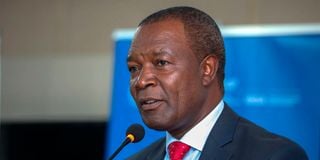Premium
Biting cashflow pushes Ruto's govt into Sh30.2bn emergency loan from CBK

Treasury Cabinet Secretary Njuguna Ndung’u speaks at an event in December last year. The CS is likely to seek a raise of the debt ceiling.
Kenya’s stock of public debt crossed the Sh9 trillion mark for the first time in December, pushing the country closer to hitting the Sh10 trillion ceiling set by Parliament in June last year.
This is at a time a weak shilling has piled pressure on Kenya’s external debt repayments with some 69.3 per cent of foreign debt denominated in US dollars.
Data from the Central Bank of Kenya (CBK) shows public debt hit Sh9.145 trillion in December, made up of Sh4.472 trillion in domestic debt, Sh37.88 billion publicly guaranteed debt and Sh4.673 trillion in external debt.
This comes even as treasury took an emergency facility of Sh30.2 billion from CBK last week, the biggest overdraft in a week in over three years, pointing to biting cash flow pressures owing to a tough economic environment.
The debt is poised to get past the Sh9.44 trillion mark by June, according to earlier estimates by the Parliamentary Budget Office (PBO), which will be just Sh560 billion shy of hitting the ceiling.
The National Assembly in June last year increased the public debt limit to Sh10 trillion to allow the government to borrow Sh846 billion to plug the budget deficit in the 2022/23 financial year.
President William Ruto is facing a fiscal deficit of Sh695.2 billion in his first budget of Sh3.641 trillion for 2023/24, which will force Parliament to raise the debt ceiling for the second year running to keep borrowing within the law.
Treasury plans to plug the budget deficit in the next financial year through external loans of Sh198.6 billion and Sh496.6 billion domestic loans.
Debt anchor
The government is also forging ahead with plans to replace the nominal debt ceiling with a debt anchor expressed in present value terms as a ratio of the gross domestic product.
Treasury told the International Monetary Fund in December that the new framework will “strengthen the credibility of the government’s strategy to reduce debt vulnerabilities by enhancing transparency and accountability around the envisaged path to reach the medium-term anchor”.
The PBO, which advises lawmakers on budget matters, last year warned that the huge accumulation of debt will see expenditure on debt servicing and other routine expenditures continue to crowd out development funding.
Debt service expenses have increased over the last few years, from Sh850.01 billion in 2021/22 to Sh1.3 trillion in the fiscal year 2022/23. It is projected that this will increase to Sh1.8 trillion in 2024/25.
“Increased expenditure on public debt interest payments coupled with growth in expenditure on operations and maintenance have been some of the drivers of the accelerated growth in recurrent expenditure relative to economic output,” said PBO.
Debt service expense as a proportion of ordinary revenue has increased from 49 per cent in 2019/20 to 65 per cent in 2022/23. This indicates that generated revenues are increasingly being used to repay public debt, which is a non-productive expenditure, rather than to meet productive expenditure needs.
“Further, the share of ordinary revenue used to service interest payments on the public debt increased from about 15 per cent in 2013/14 to around 30 per cent in 2021/22,” it said.
To ease spending pressures in his first budget, President Ruto wants to significantly increase revenue collection, stop subsidies on fuel, electricity and food and accelerate reforms in state-owned entities to end their reliance on government funding.
Treasury expects to collect Sh2.89 trillion in revenues in 2023/24 to fund its spending, a 15.1 per cent increase from the Sh2.51 trillion estimated to be collected in the current financial year which will be supported by a retinue of new tax measures.
“The fiscal policy continues to pursue growth-friendly fiscal consolidation to preserve debt sustainability. This will be achieved through enhancing revenue collection and curtailing non-core expenditures while prioritising high impact social and investment expenditure,” said Treasury in the draft 2023 Budget Policy Statement.
Non-priority spending
President Ruto has promised to reduce non-priority spending by Sh300 billion in the current year’s budget in a cut that the Cabinet last week said will be included in the supplementary budget in a bid to reduce pressure on a broke Treasury.
“On the state of the economy, Cabinet approved the FY2022/23 Supplementary Estimates No 1 that rationalises the FY2022/23 national budget with the administration’s priorities. The supplementary budget gives effect to the Presidential directive to realise savings of Sh300 billion as a measure of containing the fiscal deficit,” stated the Cabinet statement.





